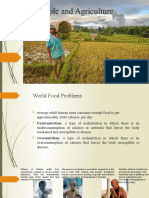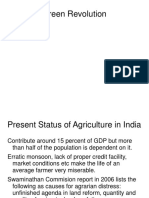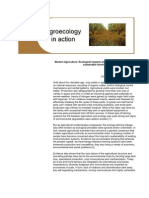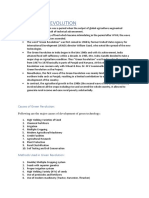0 ratings0% found this document useful (0 votes)
15 viewsSdasdqwe
Sdasdqwe
Uploaded by
LEONARDO BAÑAGARapid population growth has increased demand for food, materials, and energy, necessitating more efficient photosynthesis and conversion of photosynthetic output. The Green Revolution of the mid-20th century greatly improved agricultural yields through fertilizers, pest control, plant breeding, and mechanization, limiting famines despite population growth but not eliminating malnutrition. However, beginning in the early 1990s, the rate of yield increases for major crops like rice began to decline, and high input costs associated with sustaining agricultural production became problematic for many farmers.
Copyright:
© All Rights Reserved
Available Formats
Download as DOCX, PDF, TXT or read online from Scribd
Sdasdqwe
Sdasdqwe
Uploaded by
LEONARDO BAÑAGA0 ratings0% found this document useful (0 votes)
15 views1 pageRapid population growth has increased demand for food, materials, and energy, necessitating more efficient photosynthesis and conversion of photosynthetic output. The Green Revolution of the mid-20th century greatly improved agricultural yields through fertilizers, pest control, plant breeding, and mechanization, limiting famines despite population growth but not eliminating malnutrition. However, beginning in the early 1990s, the rate of yield increases for major crops like rice began to decline, and high input costs associated with sustaining agricultural production became problematic for many farmers.
Original Title
sdasdqwe
Copyright
© © All Rights Reserved
Available Formats
DOCX, PDF, TXT or read online from Scribd
Share this document
Did you find this document useful?
Is this content inappropriate?
Rapid population growth has increased demand for food, materials, and energy, necessitating more efficient photosynthesis and conversion of photosynthetic output. The Green Revolution of the mid-20th century greatly improved agricultural yields through fertilizers, pest control, plant breeding, and mechanization, limiting famines despite population growth but not eliminating malnutrition. However, beginning in the early 1990s, the rate of yield increases for major crops like rice began to decline, and high input costs associated with sustaining agricultural production became problematic for many farmers.
Copyright:
© All Rights Reserved
Available Formats
Download as DOCX, PDF, TXT or read online from Scribd
Download as docx, pdf, or txt
0 ratings0% found this document useful (0 votes)
15 views1 pageSdasdqwe
Sdasdqwe
Uploaded by
LEONARDO BAÑAGARapid population growth has increased demand for food, materials, and energy, necessitating more efficient photosynthesis and conversion of photosynthetic output. The Green Revolution of the mid-20th century greatly improved agricultural yields through fertilizers, pest control, plant breeding, and mechanization, limiting famines despite population growth but not eliminating malnutrition. However, beginning in the early 1990s, the rate of yield increases for major crops like rice began to decline, and high input costs associated with sustaining agricultural production became problematic for many farmers.
Copyright:
© All Rights Reserved
Available Formats
Download as DOCX, PDF, TXT or read online from Scribd
Download as docx, pdf, or txt
You are on page 1of 1
Requirements for food, materials, and energy in a world
where human population is rapidly growing have created a need to
increase both the amount of photosynthesis and the efficiency of
converting photosynthetic output into products useful to people. One
response to those needs—the so-called Green Revolution, begun in the
mid-20th century—achieved enormous improvements in agricultural
yield through the use of chemical fertilizers, pest and plant-
disease control, plant breeding, and mechanized tilling, harvesting,
and crop processing. This effort limited severe famines to a few areas
of the world despite rapid population growth, but it did not eliminate
widespread malnutrition. Moreover, beginning in the early 1990s, the
rate at which yields of major crops increased began to decline. This
was especially true for rice in Asia. Rising costs associated with
sustaining high rates of agricultural production, which required ever-
increasing inputs of fertilizers and pesticides and
constant development of new plant varieties, also became problematic
for farmers in many countries.
You might also like
- GFI 3rd Week PDFDocument19 pagesGFI 3rd Week PDFAimen fatimaNo ratings yet
- Unit 5Document16 pagesUnit 5prasadmohit386No ratings yet
- Assingment, AgronomyDocument9 pagesAssingment, Agronomysangamdhakal58No ratings yet
- Direction 2Document15 pagesDirection 2judypollante16No ratings yet
- Assignment 2 Summary Defining Agroecology and Gliessman 2014 Chapter 1Document4 pagesAssignment 2 Summary Defining Agroecology and Gliessman 2014 Chapter 1Eduardo KunNo ratings yet
- AGRICULTUREDocument31 pagesAGRICULTUREArul NishaNo ratings yet
- q 4 questionDocument7 pagesq 4 questionwhatsappdatanewNo ratings yet
- Agricultural ActivitiesDocument1 pageAgricultural ActivitiesVithal KaligotlaNo ratings yet
- Techology & Agriculture: Agriculture Refers To The Production ofDocument11 pagesTechology & Agriculture: Agriculture Refers To The Production ofcutenaga100% (2)
- Harmful Effects-WPS OfficeDocument2 pagesHarmful Effects-WPS OfficeRazel AdaNo ratings yet
- M2 Lesson 2 People and AgricultureDocument9 pagesM2 Lesson 2 People and AgriculturePia Jashope DICDICANNo ratings yet
- BR 11Document4 pagesBR 11xirsidameNo ratings yet
- Modern Agicultural PacticeDocument17 pagesModern Agicultural Pacticesilpa k sNo ratings yet
- Lec 2 Green Revolution-1Document13 pagesLec 2 Green Revolution-1filmsxdocNo ratings yet
- ShreyapptreenrevolutionDocument18 pagesShreyapptreenrevolutionGajanan Shirke AuthorNo ratings yet
- 2.meaning and Definition of Green RevolutionDocument12 pages2.meaning and Definition of Green RevolutionHuzaifaNo ratings yet
- People and AgricultureDocument40 pagesPeople and AgricultureBrad EscalanteNo ratings yet
- Green RevolutionDocument5 pagesGreen RevolutionAlex ChettyNo ratings yet
- PP Industrial Revolution New 3Document3 pagesPP Industrial Revolution New 3api-271959377No ratings yet
- Green RevolutionDocument7 pagesGreen RevolutionAmalNo ratings yet
- Harmful Effects of Green RevolutionDocument2 pagesHarmful Effects of Green Revolutionniyorraj90100% (1)
- Veermata Jijabbai Technological Institute Green RevolutionDocument8 pagesVeermata Jijabbai Technological Institute Green RevolutionRaj VishwakarmaNo ratings yet
- Climate ChangesDocument2 pagesClimate ChangesEnrique ApoloNo ratings yet
- SIH1639Document6 pagesSIH1639Mehal srivastavNo ratings yet
- Technological Development of Agriculture and Its Great DilemmasDocument3 pagesTechnological Development of Agriculture and Its Great DilemmasAngelica Mae CornejoNo ratings yet
- MathDocument9 pagesMathpauljohnmabanag23No ratings yet
- Application of BiotechnologyDocument8 pagesApplication of BiotechnologySyed Ali HadiNo ratings yet
- Spep Q1Document6 pagesSpep Q1Jesica PoetriNo ratings yet
- .....Document6 pages.....samNo ratings yet
- Balancing Food Security-MajumdarDocument10 pagesBalancing Food Security-Majumdarp.kaurNo ratings yet
- Organic Farm Project For Janfy AmalurDocument25 pagesOrganic Farm Project For Janfy AmalurMathew YoyakkyNo ratings yet
- Greer EvolutionDocument32 pagesGreer EvolutionSAIRIPALLY SAI SURYA (B16CS029)No ratings yet
- 4ADocument9 pages4Adyz2nybk8zNo ratings yet
- Abiotic EffectsDocument10 pagesAbiotic EffectsZAIHASRA BINTI AHMAD KPM-GuruNo ratings yet
- NtroductionDocument7 pagesNtroduction21ba031No ratings yet
- All About Green RevolutionDocument5 pagesAll About Green RevolutionMansi JadhavNo ratings yet
- Green Revolution in IndiaDocument8 pagesGreen Revolution in IndiaHimanshu Saini 3070No ratings yet
- AGRI 2 - Activity 2Document8 pagesAGRI 2 - Activity 2Alexis LopezNo ratings yet
- Green Revolution: January 2016Document8 pagesGreen Revolution: January 2016johns servicesNo ratings yet
- 1-IJCBS-18-14-1Document23 pages1-IJCBS-18-14-1ahmetkoseoglu24No ratings yet
- C C C C: Agroecology in Action Isidoro Revised 07-30-00Document11 pagesC C C C: Agroecology in Action Isidoro Revised 07-30-00pacharneajayNo ratings yet
- I-2 Bharadwaj Suatainable 5 - See p 31 and 35Document44 pagesI-2 Bharadwaj Suatainable 5 - See p 31 and 35g7tjps5mjtNo ratings yet
- Agro EcosystemDocument53 pagesAgro EcosystemSandesh Baral100% (2)
- Assignment Green RevolutionDocument11 pagesAssignment Green RevolutionDark Web LeakedNo ratings yet
- I Wrote An Article On Topic Hydophonics and BiotechnologyDocument3 pagesI Wrote An Article On Topic Hydophonics and Biotechnologykirtityagi103No ratings yet
- EcoDocument17 pagesEcoProvash BiswasNo ratings yet
- Food and Energy Security - 2017 - Carvalho - Pesticides Environment and Food SafetyDocument13 pagesFood and Energy Security - 2017 - Carvalho - Pesticides Environment and Food SafetyMarcos SolimanNo ratings yet
- 2015 Book GrainLegumesDocument449 pages2015 Book GrainLegumesSonia HernándezNo ratings yet
- Chapter 1 History of Crop ProductionDocument6 pagesChapter 1 History of Crop ProductionwesleyabujeNo ratings yet
- Green RevolutionDocument5 pagesGreen RevolutionPrathamesh RandiveNo ratings yet
- What Is The Green Revolution?Document6 pagesWhat Is The Green Revolution?Shahid FateenNo ratings yet
- The Role of Technology in AgricultureDocument35 pagesThe Role of Technology in AgricultureDivyesh ThumarNo ratings yet
- Green RevolutionDocument18 pagesGreen Revolutionmuhammadikramshah2002No ratings yet
- Agriculture The Backbone of Human CivilizationDocument3 pagesAgriculture The Backbone of Human Civilizationjuilee.saveNo ratings yet
- THE GREEN REVOLUTION-notesDocument12 pagesTHE GREEN REVOLUTION-notesAnshika SinghNo ratings yet
- APES Notes - Chapter Nine: The Production and Distribution of FoodDocument9 pagesAPES Notes - Chapter Nine: The Production and Distribution of FoodirregularflowersNo ratings yet
- Commercial Horticulture - With Chapters on Vegetable Production and Commercial Fruit GrowingFrom EverandCommercial Horticulture - With Chapters on Vegetable Production and Commercial Fruit GrowingNo ratings yet
- The Future of Farming - Innovations in Sustainable AgricultureFrom EverandThe Future of Farming - Innovations in Sustainable AgricultureNo ratings yet
- A Math Assistant Always at HandDocument2 pagesA Math Assistant Always at HandLEONARDO BAÑAGANo ratings yet
- What Is PhotomathDocument1 pageWhat Is PhotomathLEONARDO BAÑAGANo ratings yet
- Photomath Is A Free App That Can Solve Equations Through Smartphone CamerasDocument2 pagesPhotomath Is A Free App That Can Solve Equations Through Smartphone CamerasLEONARDO BAÑAGANo ratings yet
- PhotoDocument1 pagePhotoLEONARDO BAÑAGANo ratings yet
- Fossil Fuels Coal Oil Gas Industrial Society: SyntheticDocument1 pageFossil Fuels Coal Oil Gas Industrial Society: SyntheticLEONARDO BAÑAGANo ratings yet
- Individual Development PlanDocument3 pagesIndividual Development PlanLEONARDO BAÑAGA50% (2)
- PoertkldfDocument1 pagePoertkldfLEONARDO BAÑAGANo ratings yet
- LDM Course 2 (Module 3)Document10 pagesLDM Course 2 (Module 3)LEONARDO BAÑAGANo ratings yet
- LDM Course 2 (Module 2)Document6 pagesLDM Course 2 (Module 2)LEONARDO BAÑAGANo ratings yet
- Colegio de Dagupan Chapter: JPIA Vice-President For MembershipDocument1 pageColegio de Dagupan Chapter: JPIA Vice-President For MembershipLEONARDO BAÑAGANo ratings yet
- Chapter 2 - An Introduction To Linear Programming: Cengage Learning Testing, Powered by CogneroDocument22 pagesChapter 2 - An Introduction To Linear Programming: Cengage Learning Testing, Powered by CogneroLEONARDO BAÑAGANo ratings yet
- Rapid Assessment of Learning Resources (For Non-Deped) Is The LR Material... Yes No Cannot Be DeterminedDocument2 pagesRapid Assessment of Learning Resources (For Non-Deped) Is The LR Material... Yes No Cannot Be DeterminedLEONARDO BAÑAGANo ratings yet
- Attendance: Ldm2 Beta Test Participants Lac Session #1Document1 pageAttendance: Ldm2 Beta Test Participants Lac Session #1LEONARDO BAÑAGANo ratings yet
- Name: - Score: - Block: - DateDocument8 pagesName: - Score: - Block: - DateLEONARDO BAÑAGANo ratings yet
- Lac Schedule: LDM Module Title Date of LAC Facilitator & DocumenterDocument1 pageLac Schedule: LDM Module Title Date of LAC Facilitator & DocumenterLEONARDO BAÑAGANo ratings yet
- Ly Anne's Room Renovation! Let's G!!: (Phase I)Document5 pagesLy Anne's Room Renovation! Let's G!!: (Phase I)LEONARDO BAÑAGANo ratings yet
- Ly Anne Cereno BanagaDocument3 pagesLy Anne Cereno BanagaLEONARDO BAÑAGANo ratings yet












































































